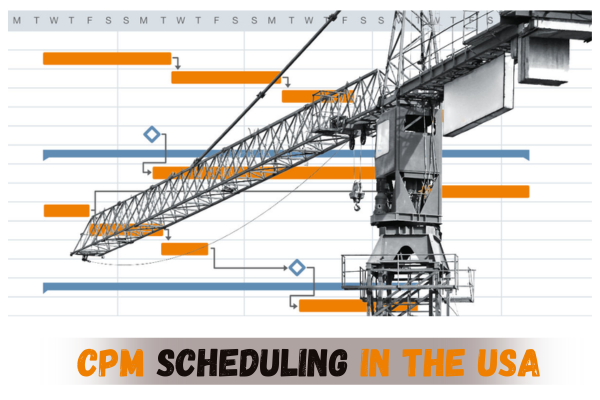CPM Scheduling: What is it?
The Critical Path Method, often known as CPM Scheduling, is a project management technique that establishes the longest chain of interdependent tasks that determines the project’s minimum completion time. The CPM scheduling procedure is broken down as follows:
- Definition of the Activity: Enumerate every task needed to finish the project.
- Sequencing of Activities: Determine dependencies between jobs and arrange them logically.
- Estimating the Duration of an Activity: Estimate how long each task will take.
- Creation of the Schedule: Create the project schedule, mapping out all tasks and their dependencies.
- Identification of the Critical Path: Find the longest sequence of dependent tasks to determine the shortest time to complete the project.
The critical path is crucial because any delay in this path will directly affect the project’s overall completion time.
Important Elements of CPM Scheduling
Understanding CPM scheduling involves familiarizing yourself with its key components:
- List of Activities: An Exhaustive list of every task involved in the project.
- Activity Durations: Estimated time needed for each task.
- Requirements: Relationships and dependencies between tasks.
- Significant events: Major progress points in the project.
- Gantt Chart: Tasks, their durations, and dependencies are displayed visually.
The Process of CPM Scheduling
Here’s a step-by-step guide to implementing CPM scheduling:
- Define the Project Scope: Understand the project’s objectives and deliverables to break it into manageable tasks.
- Create a Work Breakdown Structure (WBS): To properly assign responsibilities, divide the project into smaller, more manageable parts.
- Create the Network Diagram for the Project: Use Activity-on-Node (AON) or Activity-on-Arrow (AOA) diagrams to visualize tasks and dependencies.
- Estimate Activity Durations: Use historical data, expert judgment, or estimation software for accurate time estimates.
- Identify the Critical Path: Analyze the network diagram to determine the longest path through the project.
- Modify and Follow: Regularly update the schedule and monitor progress to address any deviations from the plan.
Benefits of CPM Scheduling
Implementing CPM scheduling offers several advantages:
- Better Project Scheduling: A precise strategy is provided by CPM, which aids in effective resource allocation and delays reduction.
- Improved Time Management: You can guarantee that project deadlines are fulfilled by keeping your attention on the important path.
- Enhanced Awareness: CPM schedules provide a comprehensive view of project timelines, facilitating better communication with stakeholders.
- Optimization of Resources: Efficient scheduling optimizes resource use, reducing idle time and ensuring effective utilization.
- Risk Management: Identifying the critical path helps in managing risks and implementing contingency plans to avoid delays.
CPM Scheduling in the USA: Best Practices and Industry Applications
Construction Sector
In the USA, CPM scheduling is vital for managing large-scale construction projects. Best practices include:
- Comprehensive Activity Analysis: Ensure every aspect of the project is covered with a detailed list of activities.
- Regular Updates: Schedules should be frequently modified to take weather and other factors into consideration.
- Integrated Tools for Scheduling: Utilize advanced software that integrates with other project management tools.
Manufacturing Industry
Manufacturing projects use CPM scheduling to manage production schedules and coordinate between departments. Best practices include:
- Optimization of Production Lines: Optimize schedules to reduce downtime and enhance efficiency.
- Supply Chain Coordination: Assure prompt material and component availability.
- Planning and Forecasting: Use CPM for forecasting production needs and aligning with business objectives.
Engineering Initiatives
CPM scheduling is crucial for managing complex engineering projects. Best practices include:
- Comprehensive Scheduling: Manage multiple phases and dependencies with a detailed schedule.
- Risk Assessment: Determine possible hazards and include backup measures.
- Cooperation: Facilitate communication between different engineering teams for a cohesive project execution.
Problems and Fixes
CPM scheduling presents challenges that can be addressed with the following solutions:
- Data Precision: For scheduling to be efficient, accurate data is essential. Assure consistent updates and accurate estimating methods.
- Handling Complexity: Use advanced scheduling software to handle complex dependencies and provide clear visual representations.
- Communication with Stakeholders: Maintain clear communication channels and provide regular updates to keep stakeholders informed.
Conclusion
With its organized approach to project planning, scheduling, and control, CPM scheduling is a key tool for project management in the United States. It is crucial in many industries, such as engineering, manufacturing, and construction, because of its capacity to pinpoint the important path and maximize resource allocation.
Project managers can improve project results, reduce delays, and successfully complete projects by being proficient in CPM scheduling. Precision Estimator provides helpful materials to assist you traverse the complexity of project management and guarantee your projects are carried out properly and efficiently, including professional advice and in-depth insights into CPM scheduling. Visit our website, EstimaCore, for additional information.
Share this Entry



